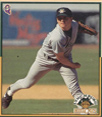Dave Daniels: Former RHP AAA Pirates
1. Could you tell us your story on dropping down?
In high school, with two strikes on a batter, I would often throw throw a sidearm pitch. I was trying either to distract him by re-focusing his sights or get him to chase a pitch out of the zone. However, during the fall of my freshman year at Vanderbilt, I was experimenting in the bullpen, and the pitching coach asked me to repeat a sidearm pitch. He called over the head coach, who immediately suggested that if I continued to develop that style, I would pitch a lot the following spring. As a freshman, I broke the school's single-season record for appearances.
2. What are some of the advantages you had from your arm angle?
A lower arm angle imposes a drastically-different view upon the batter. As a pitcher prepares to deliver his pitch, the batter typically focuses on an imaginary box through which the ball will be released. Sidearming often requires the batter to shift his sights radically. As one lowers his arm angle, he may lose some velocity but can gain significant movement of his pitches. Depending upon arm slot and grip, a sidearmer can create two planes of movement on a sinking fastball; therefore, a hard, two-seam fastball sinking down-and-in to a righthanded batter can be very difficult to hit. The results can either be a swing-and-miss, or even better, a groundball double-play.
3. If you didn't drop down, do you think you would have had the same success?
Coming out of high school, my fastball would top out at 84-85 mph, hardly enough to catch the imaginations of many college coaches and especially pro scouts. However, since I wasn't blessed with extremely high velocity, I also experimented other ways to get batters out, including the knuckleball. Had I not developed the sidearm slot, I may have pursued this pitch as far as it would have taken me.
4. What would you tell someone debating on changing their arm angle?
If considering lowering arm slot, I would ask him to make sure he is also altering (lowering) his upper body as well. The most common mistake I see with those experimenting is that they maintain too upright their posture, placing strain on their elbow and shoulder. I would also encourage sticking with it should success not immediately arrive. I enjoyed some success quickly upon dropping my arm angle, but on occasions I was also hit around pretty hard. Finally, location and movement are so much more important than velocity.
5. Are there any mechanical tips that you'd give to someone throwing sidearm/submarine?
Maintain the same distance of your hand to your head when throwing sidearm, as when throwing over-the-top: all that really changes in rotation of the trunk (upper body) toward the ground.
6. What pitches did you throw?
Two and four-seam fastballs, slider, and changeup
7. How did you pitch to lefties/righties?
Just like over-the-top, to both sides of the plate. I would focus exclusively on the bottom half of the strike zone: so much that if I missed, I wanted to miss down. Fastballs in on righties, to set up sliders down and away. Down and away from lefties with a steady stream of two-seamers and changeups.
8. Lastly what was your favorite part about pitching from down there?
Breaking wooden bats.





